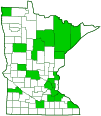limoniid crane fly
(Discobola annulata)
Conservation • Description • Habitat • Ecology • Distribution • Taxonomy
|
|
|||||||||||||
Description |
Discobola annulata is a widely distributed, medium-sized, typical crane fly. It occurs in Europe, Asia, and North America. In the United States it occurs from Maine to Maryland, west to Minnesota and Illinois, and south along the Appalachian Mountains to northern Georgia. It also occurs across southern Canada from Nova Scotia to British Columbia. Adults are active from June through October. They are found in wet or moist deciduous woodlands near streams or small rivers. They are seen on moss-covered bases of trees, in hollow logs and other protected places, and occasionally on tree trunks. The larvae are found under the bark of decaying wood. Adults are 5 ⁄16″ to 7⁄16″ (8 to 11 mm) in length. The body is yellowish brown or yellowish greenish brown. It is subtly shiny, and it has a sparse, grayish, powdery coating (pruinose). The head is dark brown. It has erect brown hairs and a gray pruinosity. The eyes are large. The antennae have 14 segments. The first segment (scape) is dark brown. The second segment (pedicel) is short and lighter brown. The remaining segments (flagellomeres) are dark brown. Each flagellomere has an ascending hair on the outer margin and a distinct, highly contrasting, yellowish, stalk (pedicel) at the tip. From a distance, this gives the antennae a banded appearance. The snout (rostrum) is brown to dark brown. The thorax is light brown. The plate at the front of the thorax (pronotum) is distinctly longer than wide. It is yellowish on the upper surface, and there is a brown stripe on the sides. The next and largest plate (prescutum) is mostly yellowish brown with a brown longitudinal line in the middle, a spot on each side of the line, and a broad dark brown stripe on each side that looks like a continuation of the stripe on the pronotum. The wings are yellowish with brown, eye-like markings along the leading edge (costal margin), the inner margin, and between. The central part of the median cell has no spots, and there are no small, dot-like spots anywhere. The legs are very long. On each leg, the third segment (femur) is yellow or light brown with a broad, dark brown ring near the tip. The fourth segment (tibia) is brownish yellow. The first one to three segments of the abdomen are green or greenish. |
Size |
Total length: 5 ⁄16″ to 7⁄16″ (8 to 11 mm) |
Similar Species |
Habitat |
Woodlands |
Ecology |
Season |
June through October |
Behavior |
|
Life Cycle |
|
Larva Food |
|
Adult Food |
|
Distribution |
||
|
Sources |
|
| 11/21/2024 | ||
Occurrence |
||
|
||
Taxonomy |
|
Order |
|
Suborder |
Nematocera |
Infraorder |
Tipulomorpha (Crane Flies) |
Superfamily |
Tipuloidea (Typical Crane Flies) |
Family |
Limoniidae (limoniid crane flies) |
Subfamily |
Limoniinae |
Tribe |
Limoniini |
Genus |
Discobola |
Some sources categorize Discobola annulata in the genus Limonia and subgenus Discobola, or just in the genus Limonia with no subgenera listed. Limonia is a very large genus, with more than 2,000 species in 41 subgenera worldwide. It is considered a “catch-all” genus, and many species will ultimately be transferred elsewhere. There is much disagreement about the proper scientific name of this species. GBIF, NCBI, and NatureServe use the name Discobola annulata, BugGuide and Discover Life use the name Limonia annulata. ITIS uses the name Dolichopeza sayi. Catalogue of the Craneflies of the World lists all three of the above names as valid, giving each of them the status of “Recognized taxon.” |
|
Subordinate Taxa |
|
|
|
Synonyms |
|
Discobola argus Discobola imperialis Dolichopeza sayi (?) Limnobia annulata Limnobia argus Limnobia imperialis Limonia annulata Tipula annulata Trichobola annulata Trichobola argus |
|
Common Names |
|
This species has no common name. The common name for the family Limoniidae is limoniid crane flies, and it is applied here for convenience. |
|
Glossary
Costal margin
The leading edge of the forewing of insects.
Femur
On insects and arachnids, the third, largest, most robust segment of the leg, coming immediately before the tibia. On humans, the thigh bone.
Flagellomere
A segment of the whip-like third section of an insect antenna (flagellum).
Pedicel
On plants: the stalk of a single flower in a cluster of flowers. On insects: the second segment of the antennae. On Hymenoptera and Araneae: the narrow stalk connecting the thorax to the abdomen: the preferred term is petiole.
Pronotum
The exoskeletal plate on the upper side of the first segment of the thorax of an insect.
Pruinescence
A waxy or powdery dust or bloom that covers the underlying coloration and gives a dusty or frosty appearance. Adjective: pruinose.
Rostrum
The stiff, beak-like projection of the carapace or prolongation of the head of an insect, crustacean, or cetacean.
Scape
In plants: An erect, leafless stalk growing from the rootstock and supporting a flower or a flower cluster. In insects: The basal segment of the antenna.
Tibia
The fourth segment of an insect leg, after the femur and before the tarsus (foot). The fifth segment of a spider leg or palp. Plural: tibiae.
Visitor Photos |
||
Share your photo of this insect. |
||
This button not working for you? |
||
Alfredo Colon |
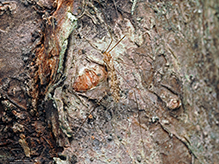 |
Robin Haire |
||
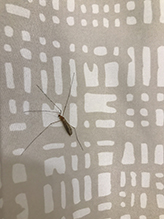 |
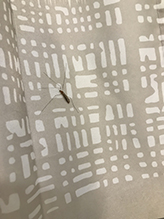 |
|
| crane fly |
|
|
MinnesotaSeasons.com Photos |
||
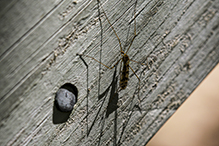 |
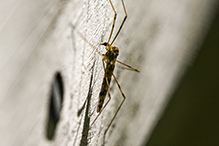 |
|
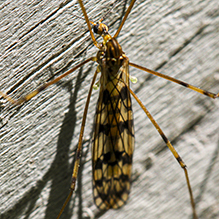 |

Slideshows |
|

Visitor Videos |
||
Share your video of this insect. |
||
This button not working for you? |
||
|
Other Videos |
||
|

Visitor Sightings |
||
Report a sighting of this insect. |
||
This button not working for you? |
||
Alfredo Colon |
Location: Albany, NY |
 |
| Robin Haire 6/4/2023 |
Location: Statesboro, Georgia crane fly |
 |
Roy Williams |
Location: Bemidji MN 56601 |
MinnesotaSeasons.com Sightings |
||

Created: 8/9/2017 Last Updated: © MinnesotaSeasons.com. All rights reserved. |
